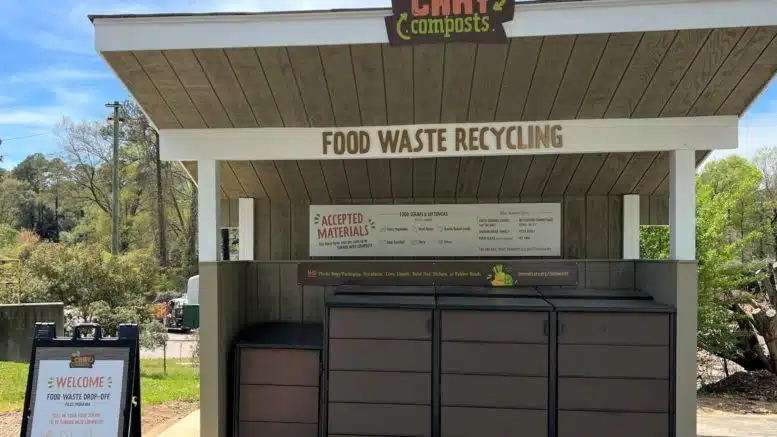By Will Atwater
Cary’s Good Hope Farm Manager Thomas Saile appreciated a recent warm spell.
“This week we had some nice warm weather and were able to get our first tilling in for the season, [which] breaks up last year’s crop residue and helps with drainage and aeration,” he said. “After that, we began applying our compost to the field.”
Establishing healthy soil is an important first step in the process of growing vegetables. Adding decomposed organic matter — compost — to soil infuses it with nutrients plants need to produce high-quality vegetables. Fortunately, Good Hope Farm has a new source of compost this year.
In 2022, the Town of Cary established a pilot food waste drop-off program to divert food waste from the landfill and to create compost now used at Good Hope Farm. The response surpassed expectations, and “the pilot’s initial goal of collecting a minimum of 16 tons of food scraps resulted in an actual collection of 40 tons,” according to a release published earlier this month.
Despite early success, Assistant Town Manager Danna Widmar knows more buy-in is needed to grow the program.
“While we continue to see increased use, we know not everyone was an early adopter. We encourage citizens to try it out if they haven’t yet.”
Food waste and climate change
Diverting food waste from landfills is a goal Widmar shares with the global environmental and scientific communities, which are concerned about the connections between food waste, a warming planet and environmental and health problems.
Food waste buried in landfills breaks down in an oxygen-deprived environment, producing methane as a by-product. Recently, NC Policy Watch reported that the Sampson County Landfill ranks No. 2 in the nation for methane emissions.
“Depending on whether you’re [measuring] by a year or 20 years, [methane is]a much more potent greenhouse gas than CO2,” said Nora Goldstein, composting expert and editor of BioCycle, a compost science journal.
In addition to methane, landfill-deposited food waste produces 170 million metric tons of carbon dioxide emissions, matching the yearly (CO2) output of 42 coal-fired power plants, according to a 2021 Environmental Protection Agency report.
The report also states that “food waste is the single most common material landfilled and
incinerated in the United States, comprising 24 and 22 percent of landfilled and combusted municipal solid waste, respectively.” Additionally, the report said, “food loss and waste represent 8 percent of human-generated greenhouse gas emissions each year.”
Researchers have warned that climate change will threaten world economies by disrupting product supply chains, reducing global food production and causing mass population displacement, among other negative impacts.
The effects on human health are predicted to include increased respiratory and cardiovascular disease, more diseases transmitted from insects as well as more heat-related deaths and other negative outcomes.
Thinking globally, acting regionally
The North Carolina Department of Environmental Quality has a map on its website that shows the location of compost facilities across the state. There are more than 50 sites on the map, representing a mixture of private and government-run composting facilities. But it’s not clear how many of the facilities compost food waste.
In addition, DEQ is providing approximately $393,000 in grant fund support to local governments, nonprofits and businesses to help divert food waste from landfills. The funding opportunities are made available on an annual basis.
One facility that’s listed on DEQ’s NC Food Donation and Compost Resource Map is roughly 250 miles west and slightly south of Good Hope Farm in Henderson County. The Henderson County Convenience Center is where residents can drop off recyclables. The county operates a transfer station and ships its garbage across the border to a landfill in South Carolina, paying roughly $40 per ton, according to Amy Schmitte, county environmental programs coordinator.
In 2017, the convenience center began a food waste drop-off program. By 2022, the facility had diverted 142.5 tons of food waste from the landfill, Schmitte said. Though the current savings is less than 1 percent of the waste management budget, the county continues to work toward expanding the compost facility and diverting more food waste from the landfill, Schmitte said.
“We accept typical food waste, but we can accept some other items that you won’t typically be able to compost at home, which is nice for folks,” Schmitte said.
Through a process known as aerated static pile composting, air is pumped from perforated pipes beneath the compost pile. The air stimulates oxygen-craving beneficial organisms that feed on the waste. During this process, the pile’s core temperature reaches 131 degrees for a 10-day period, which is hot enough to kill pathogens — even those found in meat scraps and dairy products. Pizza boxes and other paper items are also composted, according to Smittee.
Currently, the only outlet for the finished compost is the grounds of the solid waste transfer site. Smittee says that additional testing is needed to ensure that all pathogens are eliminated during the composting process before other outlets are considered.
Another food waste composter, Brooks Contractor in Goldston, is a private business that uses windrows to transform food scraps into compost for its clients. Amy Brooks, assistant facility manager, said that, on average, it takes about a year to produce compost. The process involves mixing “food waste with wood waste, animal bedding and leaves,” she said.
Once the ingredients are mixed, they are spread out into windrows, where they are turned at least five times over a three- to six-month period, Brooks said. During this time, the pile’s internal temperature must surpass 131 degrees to ensure that pathogens are killed. Afterward, “the windrow is moved to a curing pile.” Later, after a screening process that removes clumps and debris, the compost is ready to be sold, she said.
Do-it-yourself composting
North Carolinians who don’t live in communities that offer food waste composting can establish a home composting system. For those that have yard space, there are plenty of composting bins and tumblers on the market that range in size and price. Good Hope Farm offers composting workshops and sells containers that will produce roughly one cubic yard of compost.
“This [container] would be something that someone could put in their backyard. It’s got a nice little lid, it’s got a stirring tool that comes with it to keep it aerated. And this is perfect for a general household,” Saile said.
Saile also encourages first-time composters to take a composting workshop “because there’s a few ways you can go wrong. [The pile] can be too wet, or it can be too much green (nitrogen) or too much brown (carbon),” which slows down the decay of the food scraps. However, Saile said, when a bin is properly layered, the pile only needs to be turned occasionally to promote the composting process.
Goldstein warns, however, to avoid adding “meat, fish or dairy to your backyard bin because the temperatures in your compost don’t get hot enough to destroy pathogens.” Companies such as Compost Now, which is in Raleigh, provide a food waste collection service for a fee and accept meat and dairy scraps — often in exchange for access to compost for household use.
Many householders are put off by collecting compost in the kitchen, which can also collect insects that are drawn by countertop food waste containers. One way to avoid that is to store food scraps in a bag in the freezer until you’re ready to add them to the outdoor bin, Goldstein and Saile said.
While Goldstein is encouraged by the growing number of municipalities that are establishing food waste drop-off facilities, she would like to see things move at a faster pace — especially “given what we know about … the challenges with food waste in the landfill.”
Close window
Republish this article
- You can copy and paste this html tracking code into articles of ours that you use, this little snippet of code allows us to track how many people read our story.
- Please do not reprint our stories without our bylines, and please include a live link to NC Health News under the byline, like this:By Jane DoeNorth Carolina Health News
- Finally, at the bottom of the story (whether web or print), please include the text:North Carolina Health News is an independent, non-partisan, not-for-profit, statewide news organization dedicated to covering all things health care in North Carolina. Visit NCHN at northcarolinahealthnews.org. (on the web, this can be hyperlinked)
1










